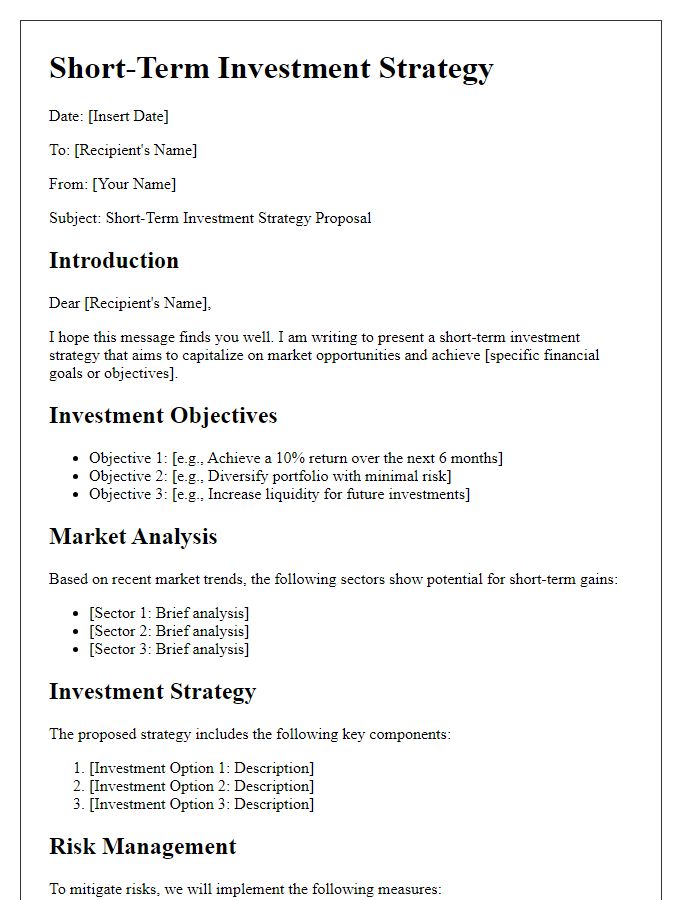Are you ready to take control of your financial future? Crafting a solid investment strategy is the key to growing your wealth and achieving your financial goals. In this article, we'll explore proven techniques and personalized approaches that can align with your aspirations. So, let's dive in and discover how you can make informed decisions for a prosperous tomorrow!

Clear Investment Goals
Establishing clear investment goals is crucial for any financial strategy. Investors need to identify specific objectives, such as retirement savings, purchasing a home, or funding a child's education. For instance, if targeting retirement, individuals might calculate a target amount, say $1 million, required by age 65. Various asset classes, including stocks, bonds, and real estate, should be considered based on time horizon and risk tolerance. Monitoring market conditions, such as interest rates or economic indicators, can inform investment choices and adjustments. Regular reviews of portfolio performance against benchmarks, like S&P 500, will help ensure alignment with long-term objectives. Adopting a disciplined approach can lead to wealth accumulation and financial security.
Risk Tolerance Assessment
Risk tolerance assessment is a critical component of any financial investment strategy, determining an individual's capacity and willingness to endure market fluctuations. Various factors such as age, income level, investment experience, and personal financial goals shape this tolerance. For instance, younger investors (ages 20-35) may exhibit higher risk tolerance, favoring aggressive strategies like stocks and venture capital, aiming for substantial growth over time. Conversely, older investors (ages 55 and above), often focused on capital preservation, might prefer conservative investments like bonds and fixed-income securities, seeking stability. Additionally, external factors such as market volatility and economic conditions influence risk assessments, necessitating regular reviews. Incorporating tools like questionnaires and simulations can help tailor personalized investment portfolios that align with individual risk profiles while maximizing potential returns.
Diversification Strategy
A diversification strategy in financial investment involves allocating capital across various asset classes to mitigate risk and enhance potential returns. This approach includes investing in equities (stocks) from different sectors like technology, healthcare, and consumer goods, as well as fixed-income securities (bonds) from diverse issuers including government entities and corporations. Real estate, commodities (such as gold and oil), and international markets also play a vital role in this strategy. By spreading investments (at least 15 different assets is often recommended) across these categories, investors can buffer against market volatility and economic downturns, such as the 2008 financial crisis and its impact on the housing market. Optimizing asset allocation according to individual risk tolerance and investment goals significantly contributes to achieving long-term financial objectives.
Performance Monitoring
Performance monitoring within financial investment strategies is crucial for assessing the effectiveness of various asset classes, such as equities, bonds, and real estate. Regular evaluation of investment portfolios involves analyzing metrics like return on investment (ROI), which measures the gain or loss generated relative to the initial capital invested, typically expressed as a percentage. Key performance indicators (KPIs) such as alpha, beta, and Sharpe ratio provide insights into risk-adjusted returns, which help investors understand how well an investment is performing compared to the market benchmark. Quarterly or annual reviews of performance can involve comparing individual asset returns with indices such as the S&P 500 or Nasdaq to identify underperforming areas. Detailed reports should incorporate specific events, such as economic downturns or market rallies, which may impact asset performance, facilitating timely adjustments to the investment strategy.
Tax Considerations
Tax considerations play a crucial role in financial investment strategies, impacting overall returns and investment choices. Various tax brackets apply to capital gains, with short-term gains taxed as ordinary income and long-term gains benefiting from lower rates. For instance, the IRS taxes short-term capital gains at rates ranging from 10% to 37%, depending on income, while long-term capital gains tax rates are typically 0%, 15%, or 20%. Certain investment vehicles, like Individual Retirement Accounts (IRAs) or 401(k) plans, offer tax advantages, allowing investments to grow tax-deferred. Additionally, tax-loss harvesting can offset capital gains, optimizing overall tax liabilities. Understanding state-specific regulations, such as those in California with its high capital gains tax, is also essential when crafting a comprehensive investment strategy.













Comments